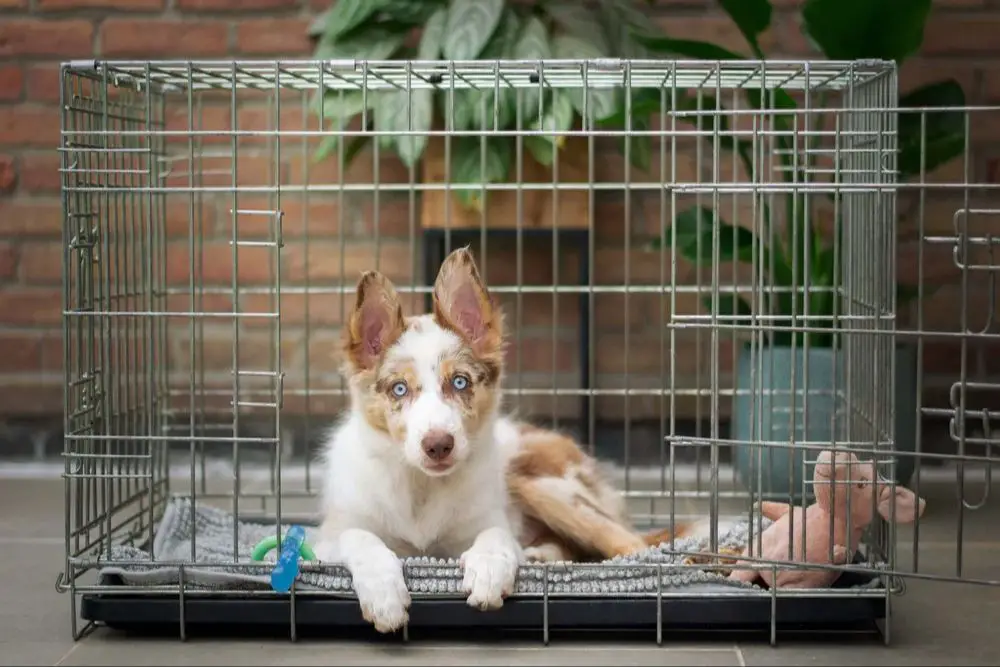Introduction
Crate training is a popular method of house training and managing dog behavior that involves teaching a dog to relax and feel comfortable spending time in a crate. The primary goal of crate training is to provide the dog with a safe space or “den” where they can rest and avoid getting into trouble while also helping teach appropriate potty habits. Properly done, many dog experts recommend crate training as an effective approach. However, some animal welfare advocates argue that crating a dog for too long or using the crate primarily for owner convenience rather than the dog’s benefit alone can be unethical. There is an ongoing debate around when and how to use crates to ensure the wellbeing of dogs. Like any training method, a balanced approach is required to make crating a positive experience for the animal.
Pros of Crate Training
Crate training can provide many benefits for dogs when done correctly. Here are some of the main advantages of crate training:
Provides Sense of Security
Dogs are den animals by nature and can view their crate as a safe space or den. This allows them to relax and feel secure when crated. The enclosed crate can provide a comforting retreat that reduces stress and anxiety in dogs.
House Training Aid
Because dogs don’t like to eliminate where they sleep, crates help teach dogs to hold their bladder and bowels. This aids in house training, preventing indoor accidents. Crates allow you to limit access until house training is completed.
Prevents Destructive Behaviors
Dogs may chew, dig, urinate, or get into trash when unsupervised. Crates prevent access to household items and contain dogs, avoiding destructive behaviors. This keeps dogs and homes safe when owners are away.

Cons of Crate Training
While crate training provides many benefits, there are some potential downsides to be aware of:
Dogs can feel confined or stressed – Just like humans, dogs are social animals who can feel anxious or frustrated when confined. If the crate is too small, the dog is crated for too long, or not properly acclimated to the crate, they may exhibit signs of stress such as whining, barking, pacing, or destructive chewing.
Risk of overcrating – While crates can be great training tools if used properly, they can be misused. Overcrating a dog by leaving them in a crate the majority of the day and/or night can lead to physical and mental health issues. Make sure your dog gets adequate exercise and socialization outside of the crate.
Difficulty adjusting – Some dogs have a harder time adjusting to crate training than others, especially if they have separation anxiety or prior negative experiences with confinement. Take the process slowly, make the crate comfortable, and positively reinforce crate training to help minimize anxiety and resistance.
Alternatives to Crate Training
While crates can be useful for some dog owners, there are several alternatives to crating that may work just as well or better for certain dogs and situations:
Baby Gates
Baby gates allow you to restrict your dog’s access to certain areas of the home while still giving them more space to move around. They are ideal for blocking off doorways, hallways, and openings between rooms. Make sure any baby gate is high enough and sturdy enough to contain your dog.
Confinement to One Room
You can use a spare bathroom, laundry room, mudroom, or other safe, dog-proofed room as your pup’s main living space when you’re away or busy. Place their bed, toys, and essentials in this room and keep them confined there when you can’t actively supervise.
Increased Exercise
Dogs that get adequate physical and mental exercise are less likely to get into trouble when left alone loose in the house. Make sure your dog gets at least 30-60 minutes of activity daily. Take them on walks, have play sessions, use puzzle toys, and practice training to help tire them out.
Guidelines for Ethical Crate Training
When used correctly, crate training can be a useful tool in a dog’s development. However, crates must be utilized ethically and humanely to avoid overcrating or misuse. Here are some guidelines for ethical crate training:
Proper crate size – The crate should allow enough room for the dog to stand up, turn around, and lie down comfortably. However, too much extra space can undermine the benefits of crating by allowing bathroom accidents. Use a divider to adjust sizing as your puppy grows.
Never use as punishment – The crate should be a safe space, not a place of isolation or punishment. Only use the crate for constructive training, management, and rest.

Schedule/routine – Stick to a consistent schedule of crating and relief breaks to establish a natural routine. Puppies under 6 months especially need regular bathroom breaks.
Make crate comfortable – Include bedding, toys, treats, and other amenities to create a den-like environment. This will encourage voluntary crate use.
By following these guidelines, dog owners can implement ethical, humane crate training practices that benefit both pup and pet parent.
Signs of Overcrating
While crates can be useful training tools when used properly, overuse of crates can cause stress and anxiety in dogs. Here are some signs that a dog is being overcrated:
Excessive barking/whining – Dogs that are crated too long will often bark, whine or cry in an attempt to get your attention. Excessive vocalizations from a dog in a crate could indicate distress.
Pacing in crate – Dogs that are anxious or uncomfortable being confined may pace relentlessly back and forth in the crate. This type of repetitive motion behavior can be a red flag.
Attempts to escape – A dog trying to dig, bite, or claw their way out of a crate is a clear sign that they are not tolerating the confinement well. They are desperately trying to free themselves.
Eliminating in crate – Most dogs will avoid soiling in their crate if possible. A dog that defecates or urinates in their crate likely cannot hold it any longer due to being crated excessively.
Paying attention to these signs of stress can help prevent overcrating a dog. Make sure crating durations are reasonable for the age and needs of your dog.
Crating Duration Best Practices
When crate training a dog, it’s important to follow guidelines for maximum crating times based on the dog’s age. Puppies under 3 months should not be crated for more than 2-3 hours at a time, as they cannot control their bladder and bowels for longer periods. Over 4 months old, puppies can handle 3-4 hours in the crate. Adult dogs over 1 year old can handle up to 8 hours in the crate while you’re at work or out of the house.
However, exceedingly long crating times are inadvisable regardless of age. Dogs should not spend the majority of their day confined. If your schedule requires an 8+ hour crate period, aim to provide ample playtime, training, and human interaction before and after crating. Additionally, give potty and water breaks immediately before and after. Never crate a dog all day and again all night.
Look for signs of overcrating including restlessness, barking, whining, pacing, and destructive chewing. If exhibited, gradually reduce crating times and increase play, exercise, and bonding. While crate training can be done humanely, excessive durations are unethical as dogs are highly social and require stimulation.
Crating Overnight
Overnight crating can be an ethical way to manage a dog when done properly. Here are some pros and cons to consider:
Pros:
- Provides a safe enclosed space for the dog to sleep undisturbed
- Prevents destructive overnight behaviors like chewing or potty accidents
- Helps housetrain puppies by teaching them to hold their bladder
Cons:
- Dog may feel confined or isolated while alone at night
- Requires waking up overnight to let the dog out to relieve themselves
- Not suitable for dogs with separation anxiety or confinement distress

Some alternatives to overnight crating include:
- Setting up a puppy playpen area with piddle pads
- Allowing access to a dog-proofed room or gated area
- Having a dog walker take them out last thing at night
Guidelines for ethical overnight crating:
- Crate only for 6-8 hours maximum overnight
- Provide regular bathroom breaks before and after crating
- Make sure the crate is large enough for the dog to stand, lie down, and turn around
- Place the crate in or near the bedroom where the dog can see the owners
- Provide a comfortable crate bed and safe chew toys
- Reward calm crate behavior with treats and praise
Crating Puppies

Crating puppies requires some special considerations. Puppies have small bladders and high energy levels, so crating duration should be limited. Most experts recommend introducing crate training at 8-10 weeks old. However, limit crating to short intervals of 30 minutes to 1 hour during the day for young puppies under 4 months old. Puppies under 6 months old shouldn’t be crated for more than 3 hours at a time.
Crating overnight is fine for young puppies as long as you take them out for potty breaks. A good guideline is puppies can sleep for 1 hour for each month of age, plus 1 additional hour. So at 2 months old, a puppy can sleep for 3 hours before needing a potty break. Make sure the crate is just large enough for sleeping – too much extra room can encourage accidents. Place puppy pads towards the back of the crate for easy cleanup.
Proper crate training from a young age will help minimize separation anxiety later on. But you must meet a puppy’s needs for socialization, play, potty, and exercise first. Never use the crate for punishment or force a puppy inside. With patience and positive reinforcement, crate training sets up good lifelong habits.
Conclusion
In summary, crate training can be an ethical and humane method for housetraining dogs when used properly. The key is to ensure crates are appropriately sized, introducing dogs to crates gradually through positive reinforcement training, and never using crates to punish dogs. Crates should allow dogs to stand, turn around, and lie down comfortably.
Excessive crating for long periods can lead to negative mental and physical effects on dogs. Most experts recommend crating puppies for a maximum of 2-4 hours during the day, and adults for no more than 6-8 hours. Overnight crating is acceptable for puppies and younger dogs, but adult dogs should sleep outside crates.
While crates can provide safety and structure when used responsibly, they should never be a substitute for proper training, exercise, and socialization. There are some alternative approaches to crating including using dog gates, confinement to a single room, or increased supervision.
Overall, when implemented ethically, crate training can be a valuable tool for housetraining and providing a quiet space for dogs. However, crates should be phased out as dogs mature if confinement is no longer needed.